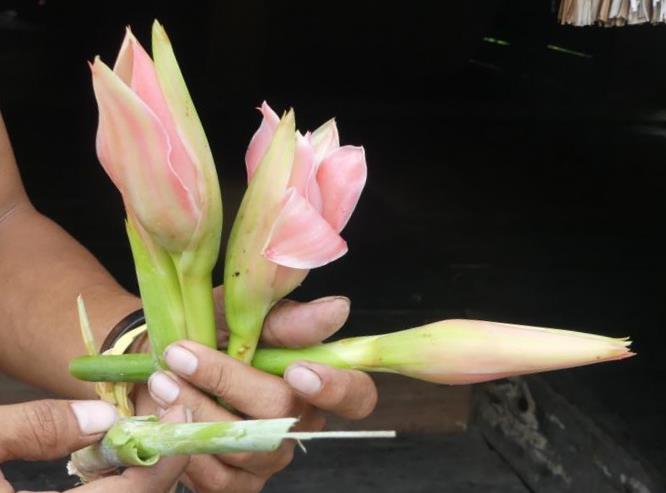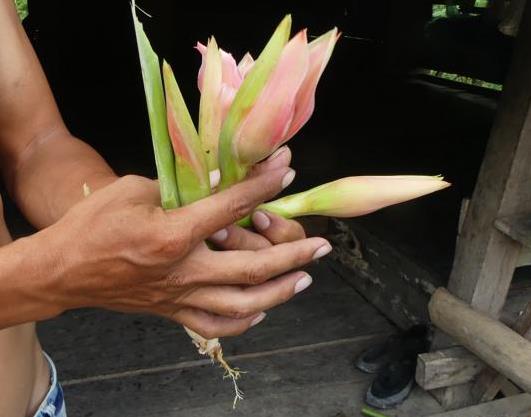Ginger flowers are eaten in many Southeast-Asian cultures. In Indonesia, most ginger varieties are known from Siberut Island. The native population of this island has utilized the flowers of Torch Ginger (Etlingera elatior (Jack) R.M. Sm.) since ancient times for medical and culinary purposes. These plants are also known under Red Ginger Lily and other local names. The Mentawai people call them ‘Tairatti’.

Brief description
These flowers have elongated buds on tall stalks with green, fleshy, fibrous stems. The buds are oval-shaped and about 10cm long and covered by protective, modified leaf coverings known as bracts.

When the flowers are young, they form a flame-like shape while tightly closed. As they bloom, the bracts open up, revealing small and colorful flower petals ranging from pink and red to white. Torch Ginger buds have a crisp texture with a piquant, sweet, sour flavor. They emit a sweet, floral, and ginger-like scent.
Use and Nutritional Value
When Mentawai people cook for larger family gatherings in connection with ceremonies, Torch ginger flowers are boiled together with meat. The lower parts of young, succulent stems are also used for cooking. On such occasions, chicken meat is most often boiled. The gingery, even lemon-like, zesty smell of these flowers perfectly complements that meat.

Besides acting as a flavoring agent, Torch Ginger flowers are rich in fiber, antibacterial and anti-inflammatory properties, and antioxidants like vitamin C. They also contain significant amounts of calcium and zinc.

Nyonya cuisine
Besides jungle cooking, Torch Ginger flowers are one of the signature elements of the Nyonya cuisine in Southeast Asia. This cuisine has been an established cooking style since the 15th century when Chinese immigrants migrated from the southern coastal areas of China to what is nowadays Malaysia, Singapore, and Indonesia. They blended their traditional Chinese cooking techniques with tropical Southeast Asian ingredients, creating dishes with new and complex flavorings, textures, and aromas.

The Chinese used soy-bean sauce to flavor their dishes, whereas Southeast Asians relied on fermented fish sauces. The Chinese added ginger flowers, with their citrus and gingery flavor, to mask the fishy notes of local dishes. This was regarded as so successful that they became an everyday flavor of the Nyonya cuisine.
Lessons learned from wild ginger flowers:
- Torch ginger is also known as Red Ginger lily.
- Flower buds and young succulent stems are boiled together with meat.
- Chicken meat, in particular, goes well with these flowers.
- Besides being a vegetable for flavoring, it contains valuable minerals and phytochemical medical properties.
- Ginger flowers are also an integral part of Nyonya cuisine in Southeast Asia.
.




